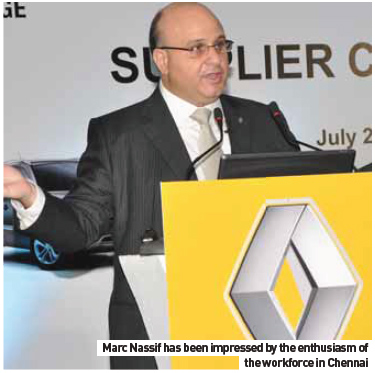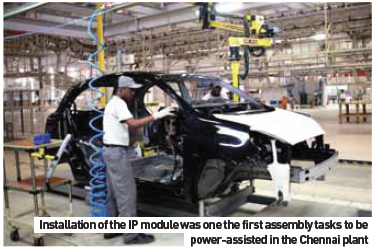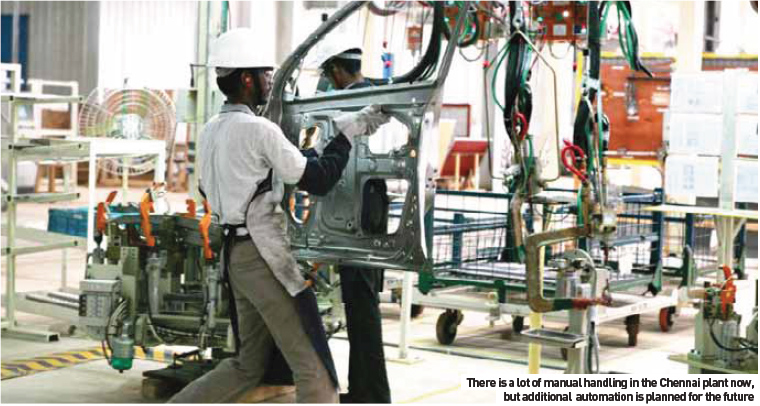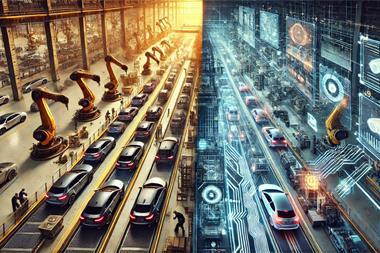 As foreign carmakers continue to build new plants in India, the changing balance of low labour cost and automation must be revisited, as evidenced at the new Renault-Nissan plant in Chennai
As foreign carmakers continue to build new plants in India, the changing balance of low labour cost and automation must be revisited, as evidenced at the new Renault-Nissan plant in Chennai
AMS talked to Marc Nassif and Akira Sakurai about the ‘automation development’ of the Chennai plant and how the carmakers have united their respective skills under the Alliance Integrated Manufacturing System (AIMS) umbrella in order to plan for the future of the facility. AMS: Chennai is an automotive hub in India, but what were the special reasons that prompted Renault-Nissan to locate its new factory there?
Akira Sakurai
Chief Executive Officer & Managing Director Renault Nissan Automotive India Pvt. Ltd.
Education
1981 Graduated from Waseda University, the Faculty of Engineering
Career Profile
2007 General Manager, Vehicle Production Engineering Control Department
2005 General Manager, Manufacturing Strategy Planning Department
2003 Nissan, Senior Manager, Body Production Engineering Dept
2000 Manager, Body Production Engineering (Nissan UK)
1997 Manager, Body Production Engineering Department
1995 Manager, Body Manufacturing, Kyushu Plant
1981 Joined Nissan Motor Company Ltd.
MN: I was here at the beginning. We looked at the three regions of carmaking in India, we decided on Chennai due to the logistics and the overall infrastructure, power, water. The workforce availability is also very good. Local and national government policies also really support the industry here in Chennai.
We ruled out Delhi simply because we wanted to be near the sea, for logistic reasons – we still receive material from abroad and 60% of Micra production will be exported. Chennai has two ports, one in the city and one 20km further north. The second is under development, but that will give us a choice of routes.
AS: The location of the port is a very important factor, when you consider the export of our production. From the beginning, we will be exporting our cars as we are looking at large volumes from the outset.
AMS: New Micra will be the first 'flagship' car that you make fully in Chennai. Will the Koleos CUV and Fluence saloon remain SKD, or could they move into full production?
MN: In Renault and Nissan, we have two different types of cars being made here in India. We have Micra, which will be fully-produced in India, plus a B-segment car from Renault which be a high-volume car in India. We have said that starting in mid-2011, over the next two years, we will launch five cars. Looking at the markets, we expect the first two to have volumes of between 2,000 and 12,000 units per annum. The Koleos, a high-end CUV with a range of world-class features, will sell approximately 2,000upa. This model will be assembled in India but not sourced here. With Fluence, considering volumes of 10,000upa, we can start thinking about some localisation of component sourcing, but not a great deal.
Marc Nassif
Country General Manager - India
Managing Director, Renault India Pvt Ltd.
Deputy Managing Director – Renault Nissan Automotive India Pvt. Ltd.
Director – Alliance Ultra-Low-Cost Car Development
Marc Nassif is currently Country General Manager for Renault & Deputy Managing Director of Renault Nissan Automotive India Pvt. Ltd, overseeing all Renault Group activities in the Indian market. He played a key role in negotiations with the Govermment of Tamil Nadu state to fi nalize construction of the 400,000upa Renault-Nissan plant
in Chennai.
Nassif joined Renault in 1985 and has held positions in engineering, manufacturing, quality and HR. He worked wth Renualt in Europe,
Asia, the US and South America, where in 2001, he launched a new Renault plant in Brazil, one of the fi rst to cross-manufacture for Renault and Nissan.
Very few manufacturers in this segment are localising parts sourcing in any large numbers. Due to the low volumes, even some of our competitors have very few localised-to-India components. For our part, we build cars here not only to avoid the high customs duty, but also as a guarantee to our buyers that the cars will have full service and parts support here.
AMS: You sourced your automation equipment from some traditional partners, ABB, etc. Did you put out tenders to many local robotics developers or other regional technology companies?
MN: One example of local sourcing on our assembly line comes from PARI, a company based in Pune. This is a departure from our usual machinery sourcing policies, but we have not only taken PARI in Chennai, but also for a new line producing engines in Europe, at Cléon (a major Renault powertrain plant), near Rouen, France. Sourcing equipment in Chennai has been a great opportunity for the Alliance to discover new suppliers. Our objective here is to be the most ‘Indian’ that we can be.
In addition to sourcing machinery, the Alliance also has two ‘logistics platforms’. These are for sourcing and shipping components from Pune and Chennai for Renault and Nissan plants abroad.
AS: Our policy is to source machines locally as much as possible, depending on quality, cost and speed of delivery. The lack of import duty and the exchange rate can also favour buying locally.
AMS: Can you tell us about how line automation was specified? Did you use an integrator to specify all the production  equipment or did you insist on certain suppliers for these machines?
equipment or did you insist on certain suppliers for these machines?
AS: In the bodyshop, we used the Nissan Tool and Machine Plant Division as integrators to specify machines. Renault and Nissan divisions worked together to make an Alliancestandard plant layout and meet specification. The actual planning and implementation was led by Nissan Tool and Machine Plant Division. As much as possible we try to utilise existing company resources.
AMS: Did you have engineers from Japan to implement the ‘Nissan Way’ of conveyor and production cell technology and layout?
AS: There is tremendous synergy here. Some engineers came from Japan and also some from Renault in France. MN: Taking the paintshop as an example, this is not a turnkey that we awarded to a paintshop builder. We took the pre-treatment cells from Geico, with a team of experts from Renault to advise; this is an area of operations where Renault holds the expertise. The rest of the paintshop has been built by Taikisha, working with the Nissan team. We take the best skill sets from the Alliance and put them together with the best suppliers. We prefer this approach to buying a full turnkey production cell, as we have better control over the cost and the specification.
 This means that the total paintshop was built by three groups; we developed the building, the pre-treatment was done by Geico and the finishing line by Taikisha.
This means that the total paintshop was built by three groups; we developed the building, the pre-treatment was done by Geico and the finishing line by Taikisha.
AMS: Backing up to body-in-white, can you tell us how the procurement strategy works in buying robots, for example? Are these specified by yourselves or are you guided by your integrator/cell builder?
AS: We would make these decision between Nissan and Renault. Our Process Engineering Division has a team which discusses the situation and specifies some of the machinery buying. An example of this is in roller hemming; ABB had already developed a roller hemming cell system for a Renault plant, so it was an obvious choice for us at Chennai. We made some modifications to increase flexibility to suit our production method, which is more of a random-order production system. We are not fixed in our choice of robots and other machines. If it is appropriate, we are open to looking at new suppliers.
AMS: You have built in a lot of flexibility, with the highspeed jig changeover capabilities. Can you tell us exactly how this works?
AS: With our ‘random production’ method, we often have to make changes based on the platform or model. These can be made in batches as low as a single unit. We need the capability to be able to accommodate up to four different platforms and eight different upper bodies. To cope with this, we have brought jig changeover time down to 10 seconds, the same time it takes for the body to advance between stations. This is a similar system to the line in Sunderland, UK – which I helped to install.
Timeline
Renault has 46,000 employees in Europe, including 700 managers working at the manufacturing departments in six car assembly plants, three in France, two in Spain and one in Slovenia and also eight powertrain plants, five in France, two in Spain and one in Portugal.
Manufacturing functions
The body-assembly sector consists of four main activities - stamping, BIW assembly, paint and final assembly, supported by three technical support functions: logistics, quality and maintenance (plus other functions, including human resources). The Manufacturing department also co-ordinates plant functions, manages progress plans and ensures industrial uniformity throughout Renault’s manufacturing sites, including those reporting to other divisions (LCVs) or located in other global regions (Brazil, Argentina, Chile, Turkey, Romania, etc.).
Reporting line
Basic Work Team leader: Manages teams of up to 20 employees. Shop foreman: In most cases, shop foremen are highly-experienced engineers or supervisors. Five years of experience as a shop foreman can serve as an excellent gateway to engineering functions in process design.
Production Department manager: Members of the engineering and managerial staff and production department managers are each entirely responsible for a specifi c car manufacturing technology and receive support from the shop foremen in their day-to-day duties.
Powertrain engineering
More than 5,000 people currently work in the Powertrain Engineering department (DIM), including 1,000 staff working at production sites in France, Spain and Portugal.
There are three main skill groups in Powertrain engineering: powertrain product design, engines and gearboxes. These jobs involve the creation of new engines and gearboxes which fulfi ll performance and cost objectives while meeting technical standards for the environment. Half of DIM employees, approximately 2,000 staff, 40% of whom are engineers, work in this domain.
Job profiles for powertrain designers include: engineers and technicians with general training in mechanical design, as well as specializations in combustion, fl uid mechanics, thermodynamics, acoustics and tribology. Electronic control systems design employs engineers and technicians specialized in electronics, automatic control, power assistance, computer science and measurement.
Design and implementation of production facilities
Employees in this area are charged with designing the production facilities for new engines and gearboxes by modifying production lines. Production facilities must meet quality and cost optimization objectives. Over 900 staff work in this area, most located on-site in active production plants (France, Spain, Portugal). Employee profi les include: powertrain production engineers and technicians specialized in robotics, control and logistics.
Test implementation
Prototype testing employs 600 people who contribute by making fi nal adjustments to new components. For this area, the DIM requires candidates to be technicians (Bac+2, Bac+3 or equivalent), with training in engines, gearboxes and physical measurement. In addition, the Powertrain Engineering department reserves a certain number of positions for experienced engineers, either generalists, specialists or those with experience in project management.
The Powertrain Engineering department also places emphasis on quality. This cross-functional activity aims to develop optimal work procedures for QCD (quality, cost and delivery times). Profi les sought are those of engineers and technicians specializing in quality analysis, assurance and statistics.
Of course in Sunderland, there are more robots and automation, but the principle is the same. Fixture points for the jigs are moved manually in Chennai, as they are in our plant in China. We have copied the best practice in this area from China. The system is designed to allow additional automation in the future; the pallet system we use is very flexible and will allow us to increase the number of stages, extend the lines and install more robots quite easily.
AMS: Your material handling equipment - lifters, handlers, etc. Are these machines helping you to keep automation lower, by helping workers to handle larger parts without automating sections of the conveyor?
AS: Again, for this we took a lot of best practice from China; the Dongfeng Nissan plant is a model for us, in using manual handlers to help the operators work efficiently and safely.
AMS: Can you tell us about the conveyor systems in use - skillet, power-and-free, chain etc? Overhead conveyors, C-carriers, etc?
AS: We use pin-type locators for mounting the body-inwhite to the conveyor. Based on this, we have installed a highly-flexible system, from Korean overhead conveyor maker Hyundai Heavy Industries. They have done very well, delivering and installing within the scheduled time. We use a standard pallet conveyor system in the bodyshop; this is an Alliance-standard system. This system was designed and made by Nissan Tool and Machine Plant Division. They purchased the parts from many sources, in Korea, China and Thailand. Some parts of the system are assembled and tested in Japan and then shipped to India as per the AIMS policy.
AMS: With regards to power tooling, are all your assembly stations using automated fastening systems or are you using some manual fitting without measurements?
AS: The best example of this is the marriage station, where the body meets the powertrain. Half of the fasteners are located and mounted manually, so you might call this a semi-automated procedure. As to fastener measurement, we have adopted torque recording by wireless communication to centrally-controlled PLCs and we also record and monitor turn counting.
AMS: How sequenced and demand-driven is your production scheduling? To what extent are you building for stock and how much to dealer and customer orders?
AS: In India, the domestic market output is 100% random; it is built to order. The difference between build-to-order’ in India and elsewhere is that the customer in India will not wait for his or her car, they want it immediately. This means the build orders are based on dealer predictions. We call our dealers our intermediate customers.
AMS: What is your experience of the workforce in Chennai?br />br /> Are you impressed with their technical proficiency and enthusiasm?
MN: Every time I visit the new plant, I am impressed by the keenness of the workforce, their creativity and desire to learn new skills. The ability of the teams to develop new ideas and new training modules is unique, in my experience. This is very encouraging and important from the Alliance perspective, since the Chennai facility is the first greenfield plant for the Renault Nissan Alliance and also the first where the Alliance Integrated Manufacturing System is being implemented from start-up.
AS: We have taken more than 200 core staff members to the Global Training Centres at plants in the UK (Sunderland) and Japan to learn the AIMS methods. These core members return to India and train many more team members. In this way, our teams learn the manufacturing DNA of the AIMS system.


































